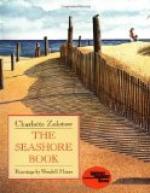[Illustration: SEA-WEED FROND.]
The Sea Lettuce or Green Laver is a common seaweed near the shore. Its broad, crinkled and bright green leaves are rather like those of a lettuce. Sometimes it is boiled to a jelly and used for food. Many other sea-weeds are good to eat, and on some coasts there is a regular sea-weed harvest.
Now wade into rather deeper water, and you find a great mass of the Bladder Wrack. Most schoolboys know it, for the little bladders of air in the leaves explode with a pop if you squeeze them. The Bladder Wrack, and others of the same kind, are torn up by the fierce waves in a storm, and tossed on the beach in heaps. They are gathered by the farmer who knows how to value a cheap manure for his fields. Some kinds are also of use in packing lobsters so that they come to market nice and fresh.
When you have walked—in your diving dress—to deep water, you find yourself among a tangle of olive-green weeds. They are below the line of low tide. All round you is a forest of dark-green ribbons with wavy edges. The ribbons are tough and very long, and cling tightly to the rocks. These ribbon-weeds, and others of the same kind, are known as Tangles. Round some parts of our coast they make wide, thick beds in the sea. Though the ribbons may be six feet long, they are not so wide as the palm of your hand.
Another sea plant, which grows in tufts in rather deep water, is called Irish Moss; it is green, brown or purple in colour. I do not know why it should be called Irish Moss, for it is not a moss, and it grows all round the English, as well as the Irish, sea-coast. But sea-weeds have strange names; indeed, many of them have no everyday names at all. Irish Moss is used for food, after being boiled to a jelly. It can also be made into a gum or glue, and has often been so used.
Now, if you were to walk still farther on the bed of the sea, into deeper water, you would find the prettiest of all the sea plants. These are the pink and red sea-weeds. You also find them on the beach, but only after they have been torn from their home in the deep water. They grow on the rocks, in pretty coloured tufts.
If you dive still farther, into the dark depths of the sea, you find beds of ooze and slime, and rocks and weird fishes, but no plants. Why is this? Like the land-plants, these sea-plants must have light. They cannot grow in the blackness of very deep water. Can you guess why some sea-weeds are green and others red? Those growing in the shallow water of the shore are green, like land-plants, because the sunlight reaches them. Only part of the light can pass through deep water; and so, in these shady places, the sea-weed is reddish in colour.
[Illustration: SEA MAT.]
We see, then, that (1) green sea-weed grows by the shore; (2) brownish-green sea-weed likes deeper water; (3) red sea-weed grows in deep water; and (4) in very deep water there is no weed at all.




